
Transportation in the Philippines covers the transportation methods within this archipelagic nation of over 7,500 islands. From a previously underdeveloped state of transportation, the government of the Philippines has been improving transportation through various direct infrastructure projects, and these include an increase in air, sea, road, and rail transportation and transport hubs.

Cebu City, officially the City of Cebu, is a 1st class highly urbanized city in the Central Visayas region of the Philippines. It is the capital of the province of Cebu, where it is geographically located but is one of three cities that are administratively independent of the provincial government. According to the 2020 census, it has a population of 964,169 people, making it the sixth-most populated city in the nation and the most populous in the Visayas.

Epifanio de los Santos Avenue, commonly referred to by its acronym EDSA, is a limited-access circumferential highway around Manila, the capital city of the Philippines. It passes through 6 of Metro Manila's 17 local government units or cities, namely, from north to south, Caloocan, Quezon City, San Juan, Mandaluyong, Makati, and Pasay.
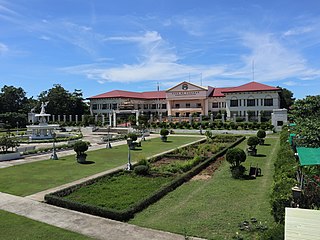
Talisay, officially the City of Talisay, is a 3rd class component city in the province of Cebu, Philippines. According to the 2020 census, it has a population of 263,048 people.
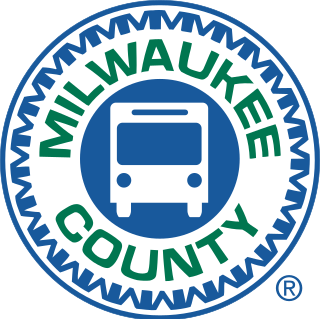
The Milwaukee County Transit System (MCTS) is the largest transit agency in Wisconsin, and is the primary transit provider for Milwaukee County. It ranks among the top 50 transit agencies in the United States for total passenger trips. Milwaukee Transport Services, Inc. is a quasi-governmental agency responsible for the management and operation of the Milwaukee County Transit System. Its bus fleet consists of 360 buses. In 2023, the system had a ridership of 17,507,900, or about 57,600 per weekday as of the fourth quarter of 2023.
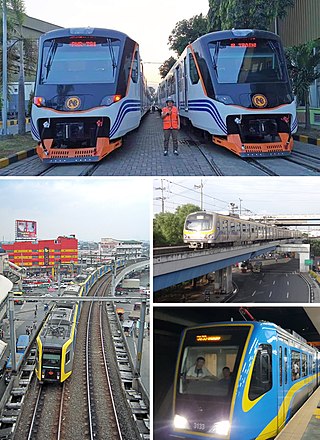
Rail transportation in the Philippines is currently used mostly to transport passengers within Metro Manila and provinces of Laguna and Quezon, as well as a commuter service in the Bicol Region. Freight transport services once operated in the country, but these services were halted. However, there are plans to restore old freight services and build new lines. From a peak of 1,100 kilometers (680 mi), the country currently has a railway footprint of 533.14 kilometers (331.28 mi), of which only 129.85 kilometers (80.69 mi) are operational as of 2024, including all the urban rail lines. World War II, natural calamities, underspending, and neglect have all contributed to the decline of the Philippine railway network. In the 2019 Global Competitiveness Report, the Philippines has the lowest efficiency score among other Asian countries in terms of efficiency of train services, receiving a score of 2.4, and ranking 86th out of 101 countries globally. The government is currently expanding the railway network up to 1,900 kilometers (1,200 mi) by 2022 through numerous projects.
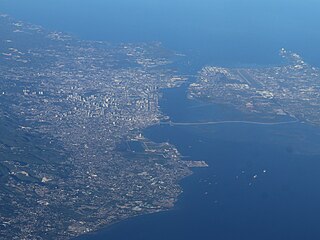
Metropolitan Cebu, or simply Metro Cebu,, is the main urban center of the province of Cebu in the Philippines. Metro Cebu is located along the central eastern portion of the island including the nearby island of Mactan. It accounts for 19.9 percent of the land area and 61.5 percent of the population of the entire province of Cebu.

The legislative districts of Cebu are the representations of the province of Cebu in the various national legislatures of the Philippines. At present, the province is currently represented in the House of Representatives of the Philippines by its seven congressional districts, with their respective representatives being elected every three years. Locally, the districts are also allotted two seats in the Cebu Provincial Board, with board members also being elected every three years.
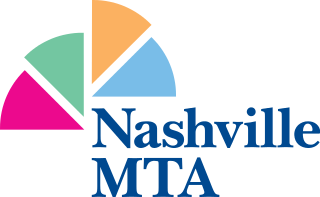
The Nashville Metropolitan Transit Authority, which does business as WeGo Public Transit, is a public transportation agency based in Nashville, Tennessee. Consisting of city buses and paratransit, the system serves Nashville and Davidson County. In 2023, the system had a ridership of 7,634,900, or about 27,700 per weekday as of the fourth quarter of 2023. For 2023, the Nashville MTA expected to collect $5.2 million in fare revenue and to spend $99.3 million in operation. To make up most of the difference, MTA expected to collect subsidies from the city, state, and national governments.

The Geary Bus Rapid Transit project added bus rapid transit features to San Francisco Municipal Railway bus lines along Geary Boulevard. The corridor serves routes 38, 38R, 38AX, 38BX which combined to serve 52,900 daily riders in 2019, the most of any corridor in the city. The project added transit-only lanes, painted red, along many sections of Geary between the Transbay Transit Center and 33rd Avenue. After the project’s completion, over 75% of Geary corridor now has transit lanes.

The University of Cebu (UC) is a private, non-sectarian, coeducational basic and higher education institution in Cebu City, Philippines. It was founded in 1964 offering preschool, grade school, junior & senior high school, undergraduate degrees, and post-graduate degrees. It currently has five campuses.

Janmarg, also known as Ahmedabad BRTS, is a bus rapid transit system in Ahmedabad, Gujarat, India. It is operated by Ahmedabad Janmarg Limited, a subsidiary of Ahmedabad Municipal Corporation and others. It is designed by CEPT University. It was inaugurated in October 2009. The network expanded to 89 kilometres (55 mi) by December 2017 and 160 km by March 2023; with daily ridership of 3,49,000 passengers. BRTS won several nation and international awards for design, implementation and operation. It was rated Silver on BRT Standard in 2013.

The transportation system in Metro Manila covers the road network, rail network, ferries, ports and airports located with the metropolitan Manila area. Road transportation in Metro Manila is diverse, composed of many types of private and public transport vehicles. These include Taxis, buses, jeepneys, tricycles and pedicabs. In some areas, especially in Divisoria and large public markets, two-stroke motors are fitted in the pedicabs and are used for goods transport. Regardless of modernity, horse-drawn kalesas are still used in the streets of Binondo and Intramuros. Ridesharing services such as Grab also operate within in Metro Manila.

Bus rapid transit in New Jersey comprises limited-stop bus service, exclusive bus lanes (XBL) and bus bypass shoulders (BBS). Under the banner Next Generation Bus New Jersey Transit (NJT), the New Jersey Department of Transportation (NJDOT), and the metropolitan planning organizations of New Jersey (MPO) which recommend and authorize transportation projects are undertaking the creation of several additional bus rapid transit systems (BRT) in the state.
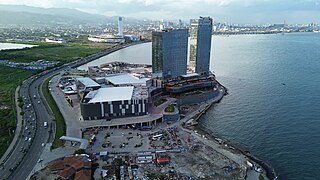
The South Road Properties (SRP), also known as the South Reclamation Project, is a 300 ha reclamation area in Cebu City, Philippines. The area, which is reclaimed from Mactan Channel, is located off the coast of the southern district of Cebu City, near Barangays Mambaling, Inayawan, and Pasil. It spans from the shore of mainland Cebu to Kawit Point. An island-type reclaimed area, it is connected with mainland Cebu by the Cebu South Coastal Road and the Mambaling Access Road. Through the Cebu–Cordova Link Expressway, the SRP is also connected by land to Cordova and the island of Mactan.
The Cebu Monorail Transit System, simply known as the Cebu Monorail, is a proposed monorail rapid transit system to be built in Metro Cebu, Philippines. Originally proposed by the Japanese in 2015 as the Cebu MRT System, it was revised to a light rail line in the late 2010s, dubbed the Cebu Light Rail Transit System or Cebu LRT. It was then again revised to its present form in late 2019.
Transportation within Cebu City is mainly land-based with most parts of the city accessible by road. There is no existing mass transit but construction is currently being undertaken on the Cebu Bus Rapid Transit System as well as an existing proposal for a Cebu Monorail, both of which will be crucial in solving the city's worsening traffic congestion, as existing transportation modes will soon become insufficient to move residents around the city if the local government fails to urgently implement infrastructure projects and measures to address the issue.
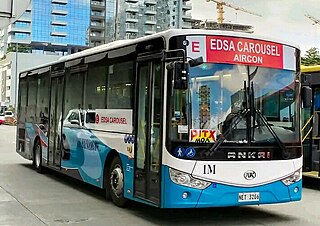
The EDSA Carousel, also known as Route 1 and formerly and still referred to as Route E, is a bus rapid transit (BRT) system, part of several bus routes in Metro Manila. It is situated along EDSA and other roads, running on a dedicated right-of-way called the EDSA Busway, separated from normal road traffic in most of its stretch by concrete barriers and steel bollards on the innermost lane.

















